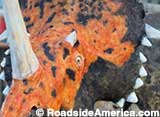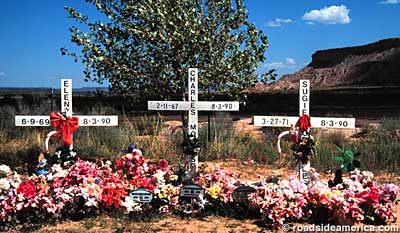
Arizona highway fatalities.
Descansos: Highway Fatality Memorials
Part 1: Thoughts From Hwy 2 in Montana
We have previously reported on debates in some areas of the country about whether or not personalized roadside death memorials should be allowed along the highways. Texas, for example, allows memorials only for those killed in DWI accidents. New Mexico, on the other hand, celebrates its markers, also known as descansos, and local newspapers report when a new one goes up.
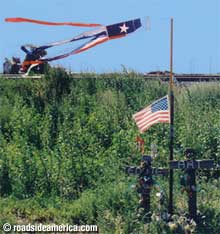
Texas: DWIs only.
In many states, personalized memorials are simply outlawed, and it's up to a state agency to honor the dead in a standardized, non-religious, bland andultimately anonymous way.
In Colorado, for example, highway shrines are forbidden. After the ACLU demanded that the state's first attempt at reminding others of the tragedy, a small wooden cross, be scrapped, the state eventually settled on a rectangular blue sign with white letters and a red 'x.' But even these can only stand for two years.
In Florida, markers were banned in 1997, and at least one radio station in Orlando -- Disneyworld Central -- offered a $100 bounty for descansos that were torn down and delivered to it. According to a news report, New Jersey allows markers along the Atlantic City Expressway to be left up for no more than 10 days, and can only be posted under police escort.
Angry organizations like "Freedom From Religion," based in Madison, WI, want them all removed, calling the markers a fad, and saying that its almost like driving through a graveyard.
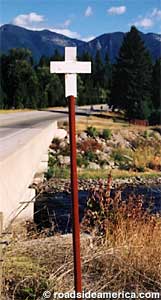
A lone Montana standardized death marker.
But it isn't a fad. Roadside markers date back almost as far as roads themselves (and certainly from the time when roads got good enough for someone to work-up a fatal accident-allowing speed) back to ancient Rome or Greece, or one of those great early civilizations.
And that's key, in our view. These markers are a sign of a civilized society. They are mysterious and touching. We've seen and photographed a lot of them over the past 15 years, and they're great, even the ones that are created by those with only a pile of rocks and a plastic dinosaur at their disposal. Certain roads, like Hwy 93 from Las Vegas, NV to Phoenix, AZ are notable in our opinion, mainly for their large collection of descansos.
The excuses to outlaw the shrines are many. Some say they are a distraction to motorists. Others worry about cars hitting those who caretake the shrines. Still others have a church/state separation axe to grind. But none of complaints really hold water, from our experience.
We thought we'd bring it up again after our recent trip along Highway 2, in northwestern Montana through Glacier National Park. Montana, too, must have some rule against the homemade memorials. Because along Highway 2 there are dozens and dozens of identical white cross markers, each one attached to a rebar, and floating at about eye level.
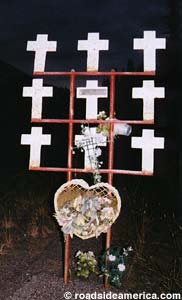
Nine person memorial in Montana.
They appear every few miles, with some tricky turns getting more than their fair share. Every once in a while, two or three crosses were attached to the same rebar, and we skidded to a stop when we turned a corner to have our headlights reflect against a 9-cross whopper. In terms of distraction, no shining collection of pinwheels and flags is nearly as attention-grabbing as a pole with nine crosses on it.
[Montana resident Brian Kelley identifies this as a late 1980s high school wrestling team school bus tragedy, where "an eastbound tanker semi-truck lost control of his second trailer in the curve and the trailer hit the westbound bus broadside in the middle of January on an icy, dark winter highway. The bus caught fire and burned entirely."]
[Update, August 2020: Allison Stanhope wrote to inform us "They are put up by the local American Legion posts in a program called the White Cross Highway Fatality Marker Program. It was started in 1953."]
A cross or other state sanctioned marker serves as a warning only. Either it says "This road is dangerous, so be careful," or "If you drink and drive around here, you're next." But it certainly doesn't give any information about the person who lost it. It also means that crumb-bums and drunks are given the same state-sponsored memorial as the well-missed.
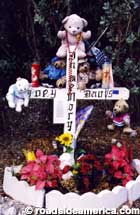
Part 2: A Controlled Observation
We have taken states to task for the great homogenization of highway death markers. Florida is one of the worst offenders. The state marks the spot of a highway fatality with a small round sign that says merely "Drive Safely." Or that's all that readable at cruising speed. If you were to drive dangerously--either by slowing down quickly, or straining to read the small type--you would also see "In Memory...Name Here."
There are a lot of these safety dots along both sides of US 1 in the Florida Keys. Billboards tell us that 15 people have already died this year, and it's only February.
We found one of them along the southbound side around mile marker 97, which proves our point, we think.
Because next to it remains the much more human tribute assembled by people that actually knew and cared about the deceased. We can make a controlled observation, placebo and active ingredient, side-by-side.
We learn nothing about Joey Davis from the state's marker. But from the unique memorial alongside, we know that Joey was a bear-loving American who, if you look closely, must have favored Jim Beam. Next to both, strapped to a telephone pole, is another lone teddy bear, perhaps the most poignant tribute of all.
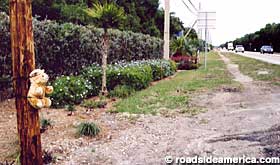
Teddy Bear strapped to telephone pole.
Part 3: South Dakota's Highway Fatality Markers
We continue to be fascinated by the official and unofficial markers of highway deaths. The unofficial tributes, called descansos, were rarely observed in South Dakota. But there were plenty of official signs erected by the SD Dept. of Transportation, part of a program started in 1979. Diamond in shape, one side says "Think," and the other side says "Why Die?" Both sides have a red "X" painted on them (definitely not a Christian cross), with "X marks the spot" in small type.
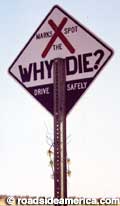
South Dakota Why Die marker.
Multiple fatalities are depicted as individual signs in a line spaced ten feet apart -- we assume this was to avoid the visual horror of signs sprouting from one spot like some abstract fatality flower.
The signs stay until they fall apart or are displaced by construction, and are not replaced unless the deceased family makes a special request.



